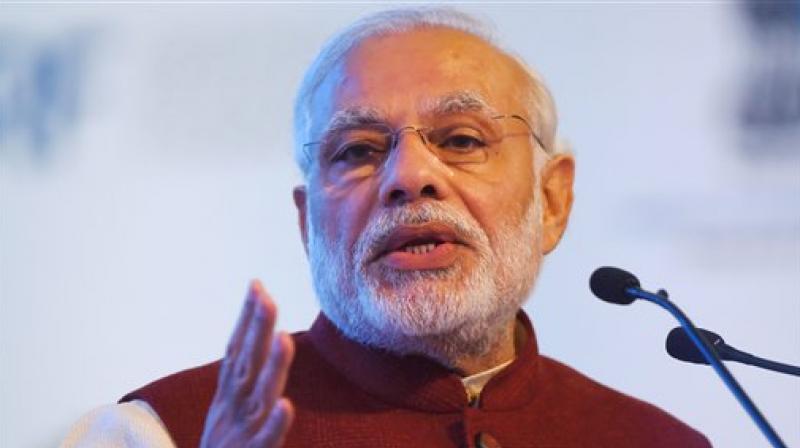Dividing Lines: Khadi symbols - Mahatma vs Modi

Narendra Modi is a serious man. More, he demands to be taken seriously. But in the very act of treating him seriously, a comic element, a combination of the macabre and the farce, enters into the analysis. The man who insists on epic definitions of himself often deteriorates to limerick and slapstick. Folk approaches make fun of his demagoguery and give his fascism a laughable touch. Viewed semiotically, Mr Modi has no real self. He thinks he is a construct and acts like one. In a visual self, the collective image began as a hoarding; by election time, he became a mask. The mask became a popular idea generating a wag’s comment of a million Modis voting for another Modi.
As his sense of the state and his stature increased, Mr Modi realised that he had be digitally produced. The hologram gave him a ubiquitous presence and provided a sense of an iconic being. A Ravan only had 10 heads. A Modi was replicated and present in every city. The next major incarnation that Mr Modi was enthusiastic about was the wax dummy at Tussauds. Mr Modi loved the search for realism of Tussauds. He praised the ruthlessness of the systematic measurements it took. A man meticulous about his 56” chest was keen that his machismo and masculinity was caught immaculately for the future. Tussauds gave Mr Modi a presence in folklore, a cosmopolitan image of being both a local and global icon. The four images together along with the all-ubiquitous photographs of him in the newspaper gave him a presence as epidemic as a Kim Il-Sung.
But there is a psychoanalytic restlessness to Mr Modi, a paranoid need to fill other spaces. He is afraid of being upstaged or not read as singular. Mr Modi’s backstage boys realised that he was a spectacle for festival or public occasions but he lacked a sense of engagement where one encountered Mr Modi in a daily sense. A calendar becomes an inevitable solution. Greeting Mr Modi in a daily way virtually institutionalises him in our lives. The rule is no citizen can avoid the PM in an everyday sense. A calendar is a classic solution. But not any calendar will do. A leader cannot be a pinup. He cannot be replaced by another image a month later. He has to be present daily and inevitably in a card calendar, the type churned out by many local groups. A bureaucratic brainwave tends to replace Mahatma Gandhi with Mr Modi as the new icon. The stiff hardboard calendar comes with the conviction that the PM as a caricature can get away playing a farce.
There are two reasons for that. The government realises it must operate as a situation balancing between brand and ideology. One realises that in Mr Modi’s Gandhi, ideas are no longer philosophical or ethical. They move from ideology to brand. Earlier Gandhi on the calendar was an iconic power. But now Gandhi appears like a half-forgotten figure, desperate for a renewing of image. But the context, complain Gandhi’s supporters, has changed. Gandhi played an ethical function. He is a mnemonic of ethical choices about technology. But when ethics becomes an official ideology or an advertising brand, it strips science seriously of its ethical power. Mr Modi shifts the context demanding an ideology. The confusion of ethics with brand and ideology is one of the great tragedies of this period. The presence of Mr Modi turns Gandhi into a lifestyle issue, while not being pursued by other communities. Second, the picture acquires an official and organic image, and moves away from issues of life and livelihood. Khadi becomes another consumer item, which can be peddled by any salesman. Gandhi’s appeal is not necessary.
But there is a different compulsiveness here. It goes beyond the changing sense of khadi. This is about Mr Modi’s need to be compulsively iconic. After having sampled the possibilities of Nehru, Patel and Vivekananda. Mr Modi tries to play Gandhi. The trouble is, he is a poor farcical version of Gandhi. I realise imitation is a sincere form of flattering but a bad imitation is illiterate, obscene and disruptive. To a violation of ethics, he adds an aesthetic mess fouling up the world of memories. He wants to create a designer khadi when khadi conveyed a sense of the aesthetic, the commons. The iconicity of the picture is destroyed by turning it into a bad advertisement. The dignity of the calendar is abandoned and Mr Modi as the substitute Gandhi turns Gandhi into one more bit player in the costume ball called Mr Modi. In caricaturing himself, he thickens the idea of a slapstick Modi. The very image of the bodies clash. The relation between body and body politic which Gandhi tried to change is abandoned. A Gandhi whose loincloth defied uniforms and official institutions is dismissed to the backstage.
A Gandhi who turned walking into a philosophy is now being conscripted to march for the nation state. Protesting against Mr Modi is futile. He has the same obsessiveness as Hans Christian Andersen’s emperor, in the story The Emperor’s New Clothes. There is no child to tell him that he is exposing himself. It is not Gandhi who loses out. One actually sees the different incarnations of Mr Modi subvert the idea of Modi. It points again to Mr Modi’s desperate need to invent himself and the poverty of that improvisation. It reminds one of Marx’s more cited quotations: “History repeats itself, first as tragedy, second as farce.” Mr Modi began as a tragedy in 2002. Today he has ascended the heights of farce. Sadly, the folklore of laughter is missing in India.

